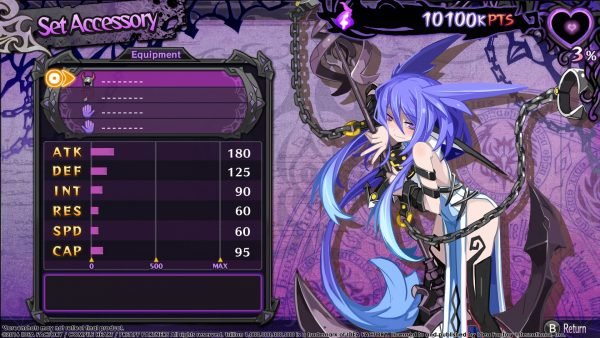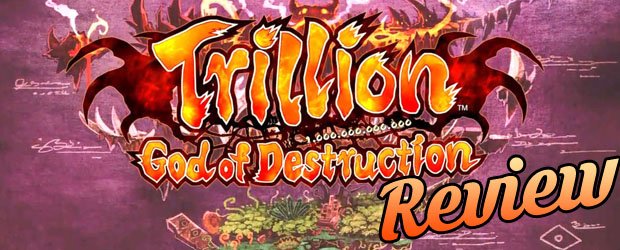Switch to: German
When first finding out about the concept for Trillion: God of Destruction, we aren’t exectly sure, how they’d pull it off. Having you face a super powered boss from the start of the game, and likely losing multiple characters along the way, doesn’t sound like it would be particularly fun. It turns out we aren’t wrong. Trillion shows that you shouldn’t try to change up the usual RPG formula just for the sake of making your game unique.

Trillion is set in the underworld, ruled by the Great Overlord Zeabolos. After his domain is attacked by a mysterious creature, he unsuccessfully attempts to to defend the Underworld and nearly dies in the process. He’s saved by a mysterious girl names Faust, who resurrects him in a weakened state. It is here that we learn of the titular Trillion, who is slowly going to devour the Underworld if left unchecked. Zeabolos, unable to fight the beast himself, has to rely on the Overlords to take the fight to Trillion in his stead. The setup for Trillion: God of Destruction is fairly compelling, but it only goes downhill from here.
See, to be able to defeat Trillion and save the Underworld, Zeabolos must aid in the training of each Overlord he selects. The majority of this is handled entirely though menu screens, with the occasional event taking place to break things up. Various training exercises are available to the Overlords, which grant points used to increases their stats. Thus begins the repetition of training your Overlord each day, supplemented with gifts that are used to increase affection.
As mentioned, affection is gained mostly by giving the right gifts, along with a lesser amount from most choices you make each day including training. Affection acts as a substitute for HP and MP until hits 0, which becomes incredibly useful for spamming abilities during the Trillion fights. This makes conserving affection during those fight important, since getting hit once will usually take away a massive amount of affection.

These menu sections get old very quickly, since there is little to them and not much to break them up. Events can occur occasionally, which will give items or affection points based on your answers. Some of these are decently written, but there are only a limited amount of events that can occur for each Overlord. On top of this, events can (and will) end up being repeated, making progression in Trillion even more tedious.
Every time you train an Overlord, you acquire tokens which are used to access the Valley of Swords. This is a randomised single floor dungeon that can be used to find items, equipment and further power up the Overlord. These sections only give you a limited amount of moves to reach the exit, so you’ll end up making use of movement abilities to reduce them amount of turns you take. The Valley of Swords gets old fast, since there is only one theme, and enemies will generally die in one hit if you’re planning out your stats properly.
Speaking of stats, not much thought seems to have been put into the balance of the upgrades you can give the Overlords. Stats like DEF and RES are pretty much useless, since you want to focus on avoiding attacks, instead of trying to survive though them. INT, which boosts magic attack power, also ends up being useless, since you want to save your MP for movement abilities when fighting Trillion. This also makes the majority of active skills not worth investing in, since your basic attack ends up being more than powerful enough later on, combined with the right passives. While you can try out a few ways of building your Overlord’s stats up, it doesn’t feel worth it in the long run with obviously broken skills available to you.

At the end of each week, you face against Mokujin, a wooden training dummy made to resemble the current form of Trillion. These act as another way to train up for the real right, and give you an idea of the moves you’ll be facing once training is over. While you get a slight taste of the battle system during the tutorial and in the Valley of Swords, this is where you’ll really have to learn how to move across the battlefield.
You see, each of Mokujin and Trillion’s attacks are telegraphed by markers on the ground, that turn more red as they’re closed to going off. Avoiding target squares is what you’ll spend most of the battle doing. The main reason for battle to be set up like this, is to slowly drain your affection until you inevitably run out and get hit by an unavoidable attack. While the way battles are set up is fairly unique for a grid based battle system like this, it starts to become annoying during later phases of the Trillion fights. It can blow you back with wind, summon additional enemies and cause portions of the floor to turn poisonous, all to stall you for as long as it can.
The reason fights with Trillion are set up this way is because of the fact that your Overlords can permanently die. The only way to play as a new Overlord, or even access certain ones, is to have your current one killed off. While you can escape a limited amount of times to train further, if you’ve not been allocating stat points properly, you will most likely lose at least one Overlord. This is intended to create emotion scenes as the Overlord does one final attack before perishing, but there isn’t really much reason to be attached to most of the characters. The limited amount of dialogue with each available Overlord means that there isn’t much time given for character building, and what is there paints most of them as annoying or childish.

The original Vita release of Trillion wasn’t so hot, with awful framerates during battle. The PC version fixes this completely, running at 60 fps without much effort, though the 3D models used don’t exactly look amazing in HD. They’re a big step down from the well drawn 2D artwork displayed in the menus and during cutscenes. The music used in Trillion is decent too, if a little lacking in variety.
Conclusion
Trillion: God of Destruction is an interesting attempt at spicing up the JRPG genre. The setup was there to create something that could be been considered unique and, more importantly, fun. But most ideas were implemented poorly, leading to a tedious and downright boring game. Hopefully more time is given to flesh out the premise of Trillion for a possible sequel, since it would be a shame for the potential of this game to be wasted.
Trillion: God of Destruction
Genre: RPG
System: PC
Price: ca. 28 Euro (digital)
Developer: Compile Heart (Hyperdimension Neptunia series, Fairy Fencer F)
Publisher: Idea Factory International
This game was provided by the publisher for review purposes, check our review policy for details.










